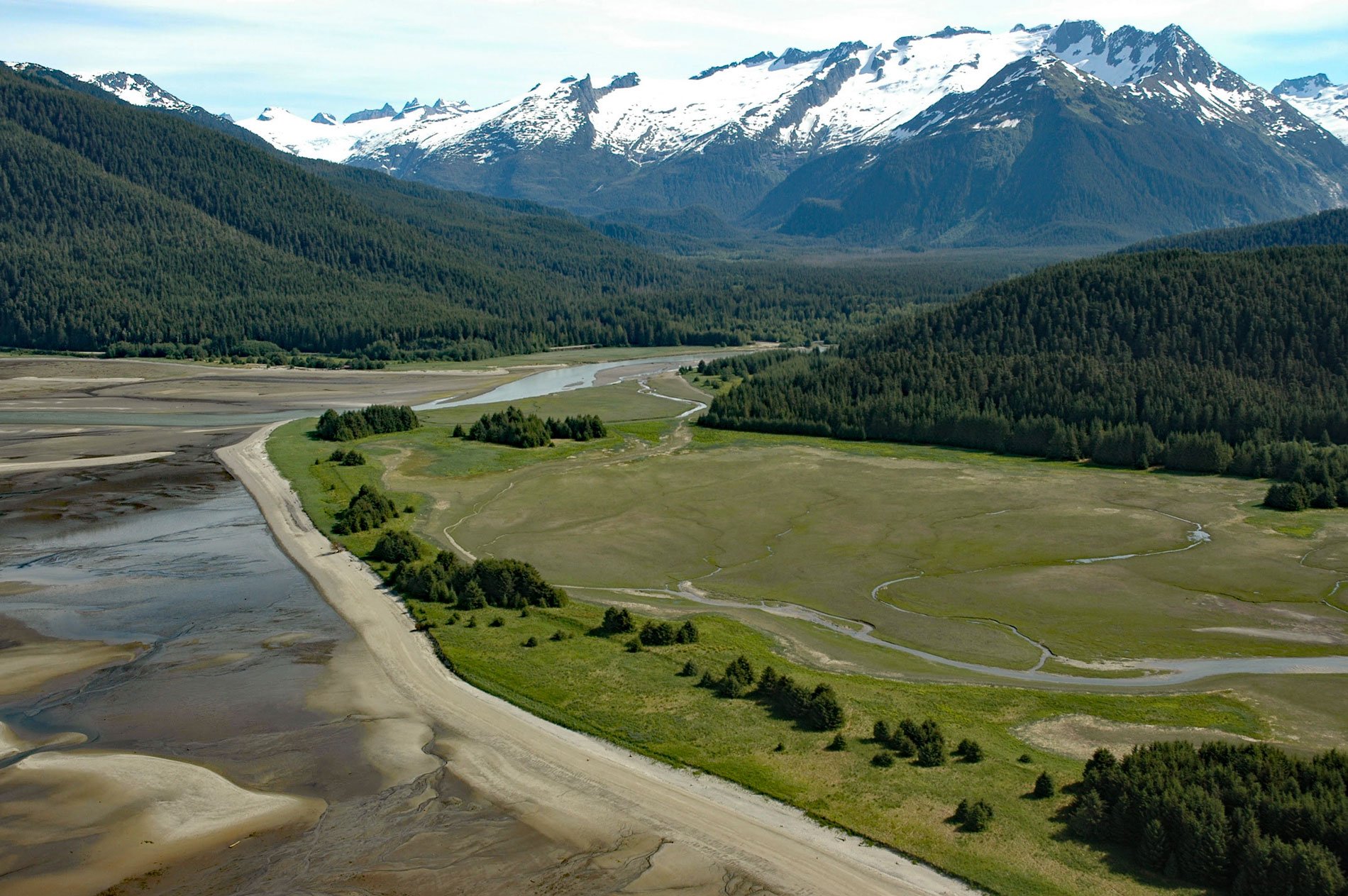Eagle Beach is at the mouth of Eagle River on the eastern shore of Favorite Channel, about 68 miles (109 km) south-southeast of Skagway and 22 miles (35 km) northwest of Juneau, Alaska. Favorite Channel is a waterway extending northwest for 16 miles (25 km) from Stephens Passage to Lynn Canal. In 1794, Lieutenant Joseph Whidbey traversed and charted the channel while serving on HMS Discovery during the Vancouver Expedition. The channel was named in 1880 by U.S. Navy officers after the steamer Favorite which was chartered from the North West Trading Company for surveying work in Alaska. Eagle River starts at Eagle Glacier in the Coast Mountains and flows about 6 miles (10 km) southwest through the Tongass National Forest, past the historical Eagle River gold mine, to the confluence of Herbert River at the head of the estuary on the eastern shore of Favorite Channel. The river mouth is opposite Shelter and Lincoln Islands, which separate Favorite Channel from Saginaw Channel to the west. At low tide, the estuary becomes a sand flat that extends over 0.8 miles (1.3 km) from shore.
On July 25, 1933, at 2:38 am, the SS Northwestern, a steamship of 336 feet (102 m) under the command of Captain C.A. Glasscock, was running southbound for Juneau at 14 knots (26 kph) in Lynn Canal with 180 passengers when the vessel went aground on a reef north of Sentinel Island. The Sentinel Island lighthouse beacon was operating, and the lighthouse keeper had warned the vessel with repeated foghorn signals. The captain was able to back away from the rock but the hull was breached and leaking badly, so he intentionally beached the vessel on the flat sandy bottom of the Eagle River estuary to prevent sinking. The passengers were put in lifeboats and lowered over the side. At low tide, salvage crews from Juneau were able to stop the leaks with a concrete patch. When the tide returned, the vessel floated and Northwestern headed south to Seattle where she went into dry dock for repairs. In a much-publicized trial after the incident, both the shipmaster and the second officer received license suspensions for negligence. Northwestern had a long and storied career in Alaska. She was built in 1889 by the Delaware River Iron Shipbuilding and Engine Works of Chester, Pennsylvania, and originally named SS Orizaba. The ship quickly developed a reputation for trouble and was frequently involved in groundings, collisions with other ships, and with port facilities. She first served as a transport in the West Indies, and in 1906 was acquired by the Alaska Steamship Company, renamed Northwestern, and sailed around Cape Horn. For the next thirty years, she worked along the Alaska coast, transporting people, mail, and goods, as well as copper ore from mines at Kennecott. In 1940, Northwestern was requisitioned by the U.S. Navy during World War II, and was serving as housing for workers at Dutch Harbor when on June 1942, she was hit by a bomb that caused extensive damage. The hulk was towed to the head of Captains Bay in anticipation of eventually being towed to Seattle, Washington, but eventually sank at the mooring.
The first recorded gold discoveries in the Juneau gold belt occurred at Sumdum Bay and Windham Bay in 1869, just two years after the Alaska Purchase. Initial production from the gold belt came from placer deposits; however, in the early 1880s, lode deposits became more important. The years between 1890 and 1915 were the heyday of the smaller mines in the region, such as the Sumdum Chief, Crystal, Comet, Jualin, Silver Queen, and Eagle River mines. The Eagle River deposit was discovered in 1902 by L.O. Sandstone and Neil Ward. The following year a 10-stamp mill was built at the Eagle River Mine and tunneling started at an elevation of approximately 1,500 feet (457 m), about 2 miles (3.2 km) southwest of the terminus of Eagle Glacier and 0.5 miles (0.8 km) west of Eagle River. A post office was established in the town of Amalga situated at the base of the mountain on Eagle River. A horse tram brought supplies delivered by steamer to the mine. In 1904, the mine upgraded to a 20-stamp mill connected to the tunnel workings by an aerial tramway, and 8,640 tons (7,838,076 kg) of ore were produced. By 1906, the Eagle River Mine had over 3,000 feet (914 m) of tunneling and 1,000 feet (304 m) of raises and shafts, and by 1912, the mine had 30,000 feet (9,144 m) of workings. In 1916, the Eagle River Mine was closed after working the quartz veins on ten levels and producing 20,000 ounces (567 kg) of gold and 8,853 ounces (251 kg) of silver during its life. Amalga had a post office from 1903 until it was abandoned in 1927. Some exploratory work was done in 1933, and in 1980, new claims were staked by Whelan Mining and Exploration Company. In 1981 and 1982, Placid Oil Company drilled several holes in the mine area. Houston Oil and Minerals Company drilled additional holes in 1985. The U.S. Bureau of Mines estimates an inferred remaining resource of 53,100 tons (48,171,510 kg) of ore with an average of 0.28 ounces (7.9 g) of gold per ton. Read more here and here. Explore more of Eagle River Beach and Favorite Channel here:

